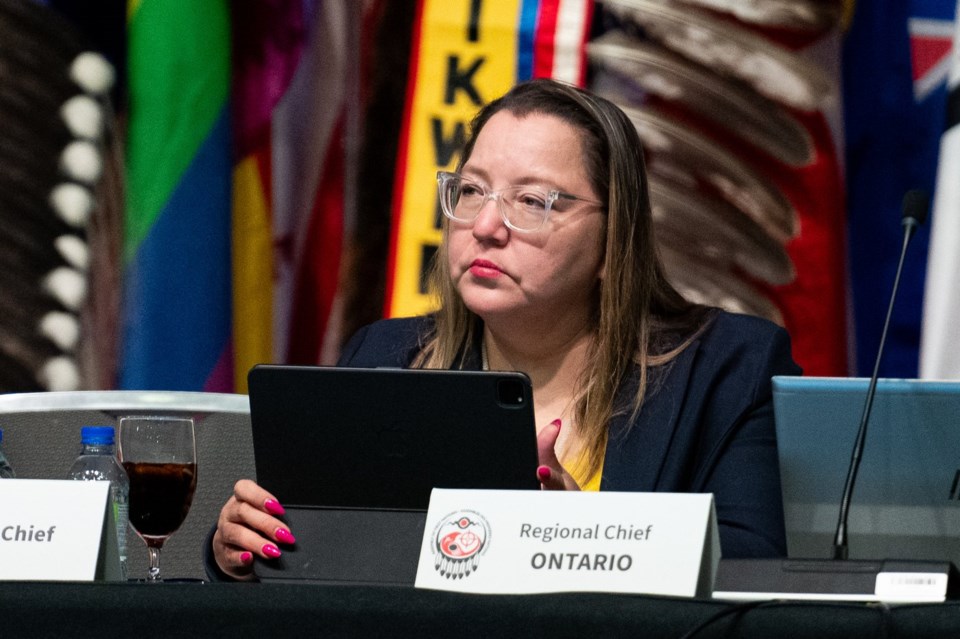WINNIPEG — Two First Nations groups are joining calls for Hudson's Bay to immediately halt the sale of artifacts and return any cultural, ceremonial and sacred items to the communities that they belong to.
The Assembly of First Nations and Manitoba Keewatinowi Okimakanak are supporting previous calls from Assembly of Manitoba Chiefs to stop the sale of items that may belong to or be linked with First Nations people.
"We want to just try (and) repatriate some of those artifacts. It's time that our stuff comes home," Assembly of First Nations National Chief Cindy Woodhouse Nepinak said Thursday ahead of a press conference.
An Ontario judge has given Canada's oldest retailer permission to move forward with an auction of the 4,400 artifacts and art pieces, along with the 355-year-old royal charter that launched the company.
Woodhouse Nepinak also voiced her pleas in letters sent to the monitor for Hudson's Bay, which is under court protection from creditors under the Companies' Creditors Arrangement Act, and to Steven Guilbeault and Gary Anandasangaree, ministers of culture and Crown-Indigenous relations.
She asks the monitor to pause auctioning so it can better understand how the items were acquired and catalogued by the company.
"While noting historical acquisition processes were very different in the past, it is possible that some of the collection may have been subjected to theft, misappropriation or illicitly acquired," says the letter dated Monday.
It adds that the Assembly of First Nations has no intention of interfering with the auction of non-First Nations objects or documents. It also asks for government help to put a pause on the auction until items have been identified and returned to their communities.
Last week, Assembly of Manitoba Chiefs Grand Chief Kyra Wilson issued a letter to the monitor saying it would "morally irresponsible" to auction off cultural and historical items without consulting First Nations.
The Bay is expected to return to court at a later date to detail exactly what items beyond the royal charter it wants to sell and how the auction process will unfold.
The Assembly of First Nations has been told the federal government may be interested in acquiring the charter, says Woodhouse Nepinkak's letter. And if that's the case, it should be put it on display in Parliament.
A lawyer representing the attorney general of Canada and several other federal government bodies, previously told court the government may be interested in acquiring some items or ensuring their cultural significance is not diminished and they're not “broken apart.”
A source familiar with the auction process, who was not authorized to speak publicly, has told The Canadian Press the items proposed to be auctioned off include paintings dating back to 1650, point blankets, paper documents and even collectible Barbie dolls.
Woodhouse Nepinak has not seen a catalogue of the items but said she believes many came from First Nations communities.
Conversations around repatriation can be difficult, she added, but it's important for the Bay to come to the table with First Nations.
The Bay, which filed for creditor protection in March because it could no longer pay its bills, wanted permission to auction off 1,700 pieces of art and more than 2,700 artifacts in hopes of helping to pay creditors.
The judge said last week that it's reasonable to let the Bay start, as long as it balances its needs with creditors and other stakeholders, and ordered the company to provide him and the Assembly of Manitoba Chiefs with a catalogue at the soonest opportunity.
The origins of the company, which started as a fur trading business, can be traced back to what was then-known as Rupert's Land, an area that now includes northern Manitoba.
Manitoba Keewatinowi Okimakanak, an advocacy group that represents some northern First Nations in the province, said its communities laid the foundation for the success of the company, starting with the first fur trading post at York Factory in 1684.
"Our history is woven into the fabric of HBC's beginnings, and reclaiming these artifacts is essential to honour and preserve the contributions and heritage of our ancestors," said Grand Chief Garrison Settee.
This report by The Canadian Press was first published May 1, 2025.
— With files from Alessia Passafiume in Ottawa
Brittany Hobson, The Canadian Press




